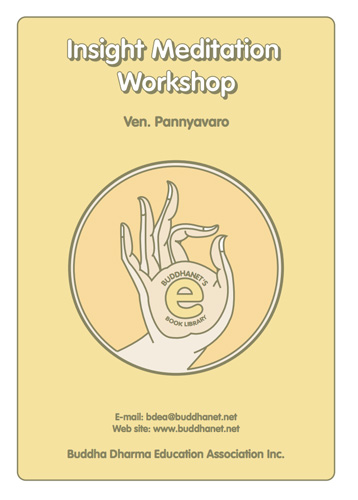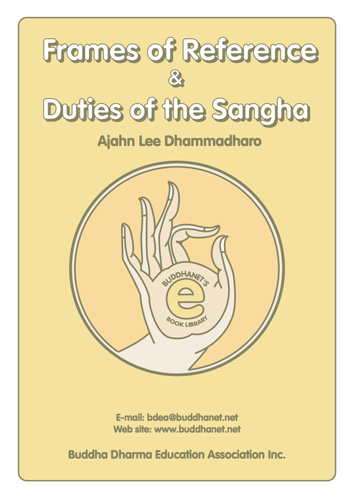 Most viewed - eBook Library Most viewed - eBook Library |

allexistence.pdfThe 31 Planes of Existence4362 viewsThe suttas describe the 31 distinct planes or realms of existence into which beings can be reborn during their long wanderings through samsara. These range from the extraordinarily dark, grim, and painful hell realms all the way up to the most sublime, refined and exquisitely blissful heavenly realms. Existence in every realm is impermanent; in the cosmology taught by the Buddha there is no eternal heaven or hell. Beings are born into a particular realm according to both their past kamma.
|
|

medwshop.pdfInsight Meditation Workshop Online4353 viewsMeditation is the intelligent heart of the Buddha's way; the only criterion is that you should apply it to daily life. The purpose of this meditation course is not to create a system of beliefs, but rather to give guidance on how to see clearly into the nature of the mind. In this way, you can have firsthand understanding of the way things are, without reliance on opinions or theories - a direct experience, which has its own vitality. This course has been prepared with both beginners and experienced practitioners in mind.
|
|

Arahattamagga.pdfArahattamagga, Arahattaphala: The Path to Arahantship4335 viewsAt present, all that is left of Buddhism are the words of the Buddha. Only his teachings ñ the scriptures ñ remain. Please be aware of this. Due to the corruption caused by the defiling nature of the kilesas, true spiritual principles are no longer practiced in present-day Buddhism. As Buddhists, we constantly allow our minds to be agitated and confused, engulfed in mental defilements that assail us from every direction. They so overpower our minds that we never rise above these contaminating influences, no matter how hard we try. The vast majority of people are not even interested enough to try: They simply close their eyes and allow the onslaught to overwhelm them. They don't even attempt to put up the least amount of resistance. Since they lack the mindfulness needed to pay attention to the consequences of their thoughts, all their thinking and all they do and say are instances of the kilesas giving them a beating. They surrendered to the power of these ruinous forces such a long time ago that they now lack any motivation to restrain their wayward thoughts...
|
|

nagarjuna.pdfThe Wisdom of Nagarjuna4326 viewsNagarjuna holds an almost unequaled place among the ranks of those Buddhist saints who expounded the teaching of the Buddha Sakyamuni for the benefit of the world. Nagarjuna revolutionized the interpretation of the doctrine of the Enlightened One which was current at his time and lent it a vitality and dynamism which has continued to sustain it even to our day among the votaries of the Mahayana. The revolution which Nagarjuna accomplished within the fold of Buddhism was not a radical departure from the original doctrine of the Buddha Sakyamuni. On the contrary, the adherents of the Madhyamaka school are undoubtedly justified in asserting that their interpretation represents the true import of the doctrine of the Buddha and the essence of Buddhism.
|
|

frames_ref.pdfFrames of Reference4313 viewsThis book on the frames of reference is based to some extent on my own thoughts and opinions. In some spots it may not be directly in line with the original text (Satipatthana Sutta), because my primary aim has been to get to the heart of the matter, so that it can be conveniently put into practice. The eBook also includes a section on the Duties of the Sangha, that is, the laws and regulations and disciplinary standards (Vinaya).
|
|

meritsutra.pdfSutra on the Merits of the Master of Healing4285 viewsSutra on the Merits of the Fundamental Vows of the Master of Healing, The Lapis Lazuli Radiance Tathagata; Sutra of the Sacred Formula of the Binding Vows of the Twelve Deva Generals to Enrich All Sentient Beings; Sutra of Tearing Away All Karma Veils. From the Chinese version of the Tripitaka Master Hsuan-tsang (T'ang, 650 C.E.) T. XIV, 450.
|
|

undrstnd.pdfTo Understand Buddhism4260 viewsThe teachings of Master Chin Kung are based on true sincerity towards others; purity of mind; equality in everything we see; proper understanding of ourselves and our environment; compassion by helping others in a wise and unconditional way. See through to the truth of impermanence; let go of all wandering thoughts and attachments; accord with conditions to go along with the environment. Be mindful of Amitabha Buddha - wishing to reach the Pure Land and follow His Teachings.
|
|

mstrhealing.pdfThe Sutra of the Master of Healing4182 viewsTranslated into Chinese from Sanskrit by Master Hsuan Tsang; Translated into English from the Chinese. This version by Professor Chow Su-Chia Ph.D., and revised by Upasaka Shen Shou-Liang.
|
|

know-see.pdfKnowing and Seeing4176 viewsVen. Pa-Auk Sayadaw
Talks and Questions and Answers at a meditation retreat in Taiwan by Venerable Pa-Auk Sayadaw. This book details two approaches to insight meditation, namely, tranquility and insight and bare-insight meditation. These two methods are essentially identical, starting from four-elements meditation and continuing into insight meditation. In this book the reader has an explanation of the classic instructions for both methods. The talks in this book were given by the Sayadaw (teacher), from Pa-Auk, Mawlamyine, Myanmar, while he conducted a two-month meditation retreat at Yi-Tung Temple, Sing Choo City, Taiwan.
|
|

04_anapanasati_sutta.pdfThe Anapanasati Sutta4141 viewsThe Anapanasati Sutta is not an easy read, although the language itself is quite simple. But its structure is complex and dense, and this complexity raises serious questions about interpretation. The complexity of the structure creates ambiguity. Even the orthodox commentary sees certain passages as capable of different but simultaneous readings, referring to either serenity or insight practice depending on what approach to the practice the practitioner is taking.
We can see how Thich Nhat Hanh can take liberties with the text, but he does so to make the practice explained within it more accessible to ordinary lay people. Are we to assume that this was not the intention of the original compilers? Or can we see the complexity of the sutta as evidence of an attempt to create a discourse that different communities of practitioners could, quite legitimately, read in different ways? In any event, if we are to make sense of this sutta, and extract from it what it has to offer in terms of guidance on the practice, we need to read the structure of the text. It is not just the surface words that convey meaning, but the underlying networks that link the words.
|
|
| 347 files on 35 page(s) |
 |
 |
 |
10 |  |
 |
 |
|
